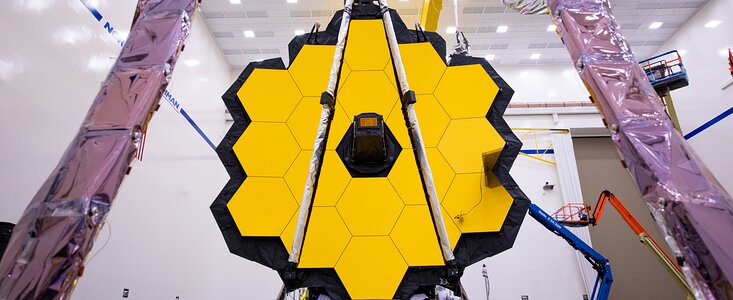weic2201 — Organisation Release
Webb Deployment Complete
8 January 2022
Today the James Webb Space Telescope team successfully fully deployed its iconic 6.4-metre, gold-coated primary mirror, completing the final stage of all major spacecraft deployments to prepare for science operations.
“The successful unfolding of the Webb telescope has been a complex but impressive engineering masterpiece. On behalf of ESA, I want to sincerely congratulate our colleagues at NASA for this achievement. Webb is an international partnership led by NASA, where ESA is providing key contributions in the form of instruments, science teams and, very importantly, a successful launch on Christmas Day from the European Spaceport in Kourou. I am grateful to NASA, CSA and our European team including CNES, Arianespace and ArianeGroup for this excellent cooperation,” says Josef Aschbacher, ESA Director General.
The two wings of Webb’s primary mirror were folded to fit inside the fairing of an ESA-provided Ariane 5 rocket prior to launch. After more than a week of other critical spacecraft deployments, the Webb team began remotely unfolding the hexagonal mirror segments of the largest mirror ever launched into space.
This was a multi-day process, with the first (port) side of the mirror deployed on 7 January and the second (starboard) side of the mirror deployed on 8 January. Mission Operations Center ground control at the Space Telescope Science Institute in Baltimore began deployment of the starboard mirror at 13:53 GMT/14:53 CET. Once the primary mirror’s second side panel extended out and latched into position at 18:17 GMT/19:17 CET, all deployments were declared complete.
The world’s largest and most complex space science observatory will now begin releasing and moving its 18 primary mirror segments to align the telescope optics. The ground team will command 126 actuators on the backside of the segmented mirrors into position and flex each mirror – an alignment process that will take months to complete. Then, the science instruments will undergo a calibration period, prior to delivering Webb’s first images this summer.
Soon, Webb will also make a third mid-course correction burn – one of three planned course corrections to place the spacecraft precisely in orbit around the second Lagrange point, commonly known as L2, 1.5 million km from Earth. This is Webb’s final orbital position, where its sunshield will protect it from light from the Sun, Earth and Moon that could interfere with observations of infrared light. Webb is designed to peer back over 13.5 billion years to capture infrared light from celestial objects with much higher resolution than ever before, and to study our own Solar System as well as distant worlds.
“We are thrilled that the complex telescope unfolding worked successfully. Now we hold our breath for the optics alignment, the instrument commissioning, and finally the fascinating first science results,” says Prof. Günther Hasinger, ESA Director of Science.
More information
Webb is the largest, most powerful telescope ever launched into space. As part of an international collaboration agreement, ESA has provided the telescope’s launch service using the Ariane 5 launch vehicle. Working with partners, ESA was responsible for the development and qualification of Ariane 5 adaptations for the Webb mission and for the procurement of the launch service by Arianespace. ESA has also provided the workhorse spectrograph NIRSpec and 50% of the mid-infrared instrument MIRI, in collaboration with the University of Arizona.
Webb is an international partnership between NASA, ESA and the Canadian Space Agency (CSA).
Image credit: ESA/ATG medialab
Links
- ESA’s Webb Archive
- Webb’s Unfolding Sequence
- ESA Webb Seeing Farther Interactive Brochure
- ESA Release
Contacts
Bethany Downer
ESA/Hubble Chief Science Communications Officer
Email: [email protected]
About the Release
| Release No.: | weic2201 | |
|---|---|---|



